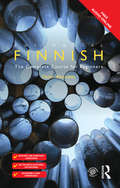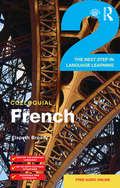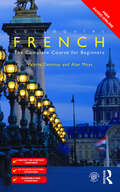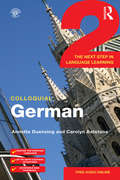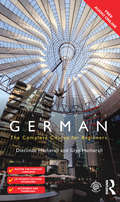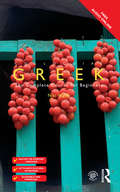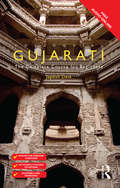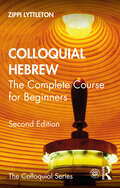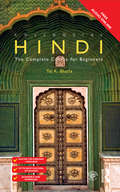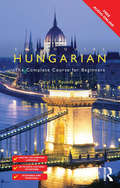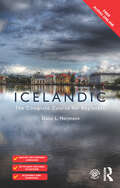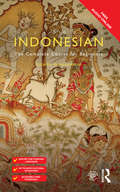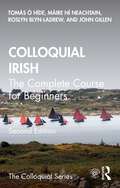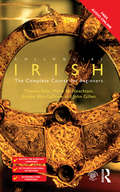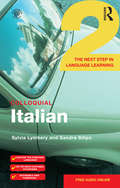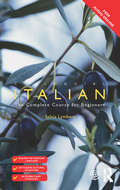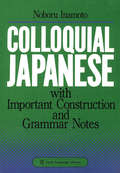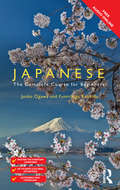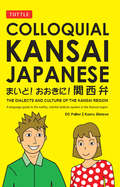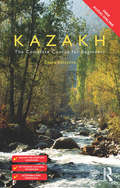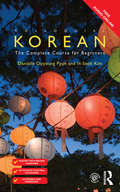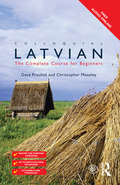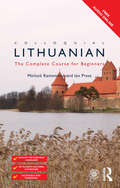- Table View
- List View
Colloquial Finnish: The Complete Course for Beginners (Colloquial Ser.)
by Daniel AbondoloColloquial Finnish provides a step-by-step course in Finnish as it is written and spoken today. Combining a user-friendly approach with a thorough treatment of the language, it equips learners with the essential skills needed to communicate confidently and effectively in Finnish in a broad range of situations. No prior knowledge of the language is required. Key features include: progressive coverage of speaking, listening, reading and writing skills structured, jargon-free explanations of grammar an extensive range of focused and stimulating exercises realistic and entertaining dialogues covering a broad variety of scenarios useful vocabulary lists throughout the text additional resources available at the back of the book, including a full answer key, a grammar summary and bilingual glossaries Balanced, comprehensive and rewarding, Colloquial Finnish will be an indispensable resource both for independent learners and students taking courses in Finnish. Audio material to accompany the course is available to download freely in MP3 format from www.routledge.com/cw/colloquials. Recorded by native speakers, the audio material features the dialogues and texts from the book and will help develop your listening and pronunciation skills.
Colloquial French 2: The Next step in Language Learning (Colloquial Ser.)
by Elspeth BroadyDo you know French already and want to go a stage further? If you're planning a visit to France, need to brush up your French for work, or are simply doing a course, Colloquial French 2 is the ideal way to refresh your knowledge of the language and to extend your skills. Colloquial French 2 is designed to help those involved in self-study, and structured to give you the opportunity to listen to and read lots of modern, everyday French. It has been developed to work systematically on reinforcing and extending your grasp of French grammar and vocabulary. Key features of Colloquial French 2 include:* a broad range of everyday situations, focusing on France and the wider francophone world* revision: material to help consolidate and build up your basics* a wide range of contemporary documents* spoken and written exercises in each unit* highlighted key structures and phrases, a grammar reference and detailed answer keys Audio material to accompany the course is available to download free in MP3 format from www.routledge.com/cw/colloquials. Recorded by native speakers, the audio material features the dialogues and texts from the book and will help develop your listening and pronunciation skills. Supplementary exercises and French language web-links can also be accessed through this site.
Colloquial French: The Complete Course for Beginners (Colloquial Ser.)
by Valérie Demouy Alan MoysColloquial French: The Complete Course for Beginners has been carefully developed by an experienced teacher to provide a step-by-step course to French as it is written and spoken today. Combining a clear, practical and accessible style with a methodical and thorough treatment of the language, it equips learners with the essential skills needed to communicate confidently and effectively in French in a broad range of situations. No prior knowledge of the language is required. Colloquial French is exceptional; each unit presents a wealth of grammatical points that are reinforced with a wide range of exercises for regular practice. A full answer key, a grammar summary, bilingual glossaries and English translations of dialogues can be found at the back as well as useful vocabulary lists throughout. Key features include: A clear, user-friendly format designed to help learners progressively build up their speaking, listening, reading and writing skills Jargon-free, succinct and clearly structured explanations of grammar An extensive range of focused and dynamic supportive exercises Realistic and entertaining dialogues covering a broad variety of narrative situations Helpful cultural points explaining the customs and features of life in France. An overview of the sounds of French Balanced, comprehensive and rewarding, Colloquial French is an indispensable resource both for independent learners and students taking courses in French. Audio material to accompany the course is available to download free in MP3 format from www.routledge.com/cw/colloquials. Recorded by native speakers, the audio material features the dialogues and texts from the book and will help develop your listening and pronunciation skills.
Colloquial German 2: The Next Step in Language Learning (Colloquial Ser.)
by Carolyn Batstone Annette DuensingDo you know German already and want to go a stage further? If you’re planning a visit to Germany, need to brush up your German for work, or are simply doing a course, Colloquial German 2 is the ideal way to refresh your knowledge of the language and to extend your skills. Colloquial German 2 is designed to help those involved in self-study; structured to give you the opportunity to listen to and read lots of modern, everyday German. It has also been developed to work systematically on reinforcing and extending your grasp of German grammar and vocabulary. Key features of Colloquial German 2 include: revision material to help consolidate and build up your basics a wide range of contemporary authentic documents, both written and audio lots of spoken and written exercises in each unit highlighted key structures and phrases a grammar reference and detailed answer keys Audio material to accompany the course is available to download free in MP3 format from www.routledge.com/cw/colloquials. Recorded by native speakers, the audio material features the dialogues and texts from the book and will help develop your listening and pronunciation skills.
Colloquial German: The Complete Course For Beginners (Colloquial Ser.)
by Dietlinde Hatherall Glyn HatherallSpecially written by experienced teachers for self-study or class use, the course offers you a step-by-step approach to written and spoken German. No prior knowledge of the language is required. What makes this new edition of Colloquial German your best choice in personal language learning? Interactive – lots of exercises for regular practice. Clear – concise grammar notes. Practical – useful vocabulary and pronunciation guide. Complete – including answer key and reference section. Audio material to accompany the course is available to download freely in MP3 format from www.routledge.com/cw/colloquials. Recorded by native speakers, the audio material features the dialogues and texts from the book and will help develop your listening and pronunciation skills.
Colloquial Greek: The Complete Course For Beginners (Colloquial Ser.)
by Niki WattsColloquial Greek: The Complete Course for Beginners has been carefully developed by an experienced teacher to provide a step-by-step course to Greeceas it is written and spoken today. Combining a clear, practical and accessible style with a methodical and thorough treatment of the language, it equips learners with the essential skills needed to communicate confidently and effectively in Greek in a broad range of situations. No prior knowledge of the language is required. Colloquial Greek is exceptional; each unit presents a wealth of grammatical points that are reinforced with a wide range of exercises for regular practice. A full answer key, a grammar index and bilingual glossaries can be found at the back as well as useful vocabulary lists throughout. Key features include: A clear, user-friendly format designed to help learners progressively build up their speaking, listening, reading and writing skills Jargon-free, succinct and clearly structured explanations of grammar An extensive range of focused and dynamic supportive exercises Realistic and entertaining dialogues covering a broad variety of narrative situations Helpful cultural points explaining the customs and features of life in Greece An overview of the sounds of Greek Balanced, comprehensive and rewarding, Colloquial Greek is an indispensable resource both for independent learners and students taking courses in Greek. Audio material to accompany the course is available to download free in MP3 format from www.routledge.com/cw/colloquials. Recorded by native speakers, the audio material features the dialogues and texts from the book and will help develop your listening and pronunciation skills.
Colloquial Gujarati: The Complete Course for Beginners (Colloquial Series)
by Jagdish DaveColloquial Gujarati provides a step-by-step course in Gujarati as it is written and spoken today. Combining a user-friendly approach with a thorough treatment of the language, it equips learners with the essential skills needed to communicate confidently and effectively in Gujarati in a broad range of situations. No prior knowledge of the language is required. Key features include: • progressive coverage of speaking, listening, reading and writing skills • structured, jargon-free explanations of grammar • an extensive range of focused and stimulating exercises • realistic and entertaining dialogues covering a broad variety of scenarios • useful vocabulary lists throughout the text • additional resources available at the back of the book, including a full answer key, a grammar summary and bilingual glossaries Balanced, comprehensive and rewarding, Colloquial Gujarati will be an indispensable resource both for independent learners and students taking courses in Gujarati. Audio material to accompany the course is available to download free in MP3 format from www.routledge.com/cw/colloquials. Recorded by native speakers, the audio material features the dialogues and texts from the book and will help develop your listening and pronunciation skills.
Colloquial Hebrew: The Complete Course for Beginners
by Zippi LyttletonColloquial Hebrew provides a step-by-step course in Hebrew as it is written and spoken today. Combining a user-friendly approach with a thorough treatment of the language, it equips learners with the essential skills needed to communicate confidently and effectively in Hebrew in a broad range of situations. No prior knowledge of the language is required. Balanced, comprehensive and rewarding, this fully revised new edition of Colloquial Hebrew is an indispensable resource for both independent learners and students taking courses in Hebrew. This edition features an engaging story line throughout the book, encouraging the student to form dialogues and develop conversational skills. Key features include: • progressive coverage of speaking, listening, reading and writing skills • realistic and entertaining dialogues covering a broad variety of scenarios • translations and transliteration provided throughout in the key • structured, jargon-free explanations of grammar • an extensive, varied range of focused and stimulating exercises • useful vocabulary lists throughout the text • additional resources available at the back of the book and on the web, including a full answer key, a grammar summary, a list of verbs used in the book, a prepositions chart and glossaries Audio material to accompany the course is available to download free in MP3 format from www.routledge.com/cw/colloquials. Recorded by native speakers, the audio material features the dialogues and exercises from the book and will help develop your listening and pronunciation skills.
Colloquial Hindi: The Complete Course for Beginners (The\colloquial Ser.)
by Tej K BhatiaColloquial Hindi: The Complete Course for Beginners has been carefully developed by an experienced teacher to provide a step-by-step course to Hindi as it is written and spoken today. Combining a clear, practical and accessible style with a methodical and thorough treatment of the language, it equips learners with the essential skills needed to communicate confidently and effectively in Hindi in a broad range of situations. No prior knowledge of the language is required. Colloquial Hindi is exceptional; each unit presents a wealth of grammatical points that are reinforced with a wide range of exercises for regular practice. A full answer key, a grammar summary, bilingual glossaries and English translations of dialogues can be found at the back as well as useful vocabulary lists throughout. Key features include: A clear, user-friendly format designed to help learners progressively build up their speaking, listening, reading and writing skills Jargon-free, succinct and clearly structured explanations of grammar An extensive range of focused and dynamic supportive exercises Realistic and entertaining dialogues covering a broad variety of narrative situations Helpful cultural points An overview of the sounds of Hindi Balanced, comprehensive and rewarding, Colloquial Hindi is an indispensable resource both for independent learners and students taking courses in Hindi. Audio material to accompany the course is available to download free in MP3 format from www.routledge.com/cw/colloquials. Recorded by native speakers, the audio material features the dialogues and texts from the book and will help develop your listening and pronunciation skills.
Colloquial Hungarian: The Complete Course for Beginners (Colloquial Series)
by Carol H Rounds Carol Rounds Erika Sólyom Erika SolyomColloquial Hungarian: The Complete Course for Beginners has been carefully developed by an experienced teacher to provide a step-by-step course to Hungarian as it is written and spoken today. Combining a clear, practical and accessible style with a methodical and thorough treatment of the language, it equips learners with the essential skills needed to communicate confidently and effectively in Hungarian in a broad range of situations. No prior knowledge of the language is required. Colloquial Hungarian is exceptional; each unit presents a wealth of grammatical points that are reinforced with a wide range of exercises for regular practice. A full answer key, a grammar summary, bilingual glossaries and English translations of dialogues can be found at the back as well as useful vocabulary lists throughout. Key features include: A clear, user-friendly format designed to help learners progressively build up their speaking, listening, reading and writing skills Jargon-free, succinct and clearly structured explanations of grammar An extensive range of focused and dynamic supportive exercises Realistic and entertaining dialogues covering a broad variety of narrative situations Helpful cultural points explaining the customs and features of life in Hungary. An overview of the sounds of Hungarian Balanced, comprehensive and rewarding, Colloquial Hungarian is an indispensable resource both for independent learners and students taking courses in Hungarian. Audio material to accompany the course is available to download free in MP3 format from www.routledge.com/cw/colloquials. Recorded by native speakers, the audio material features the dialogues and texts from the book and will help develop your listening and pronunciation skills.
Colloquial Icelandic: The Complete Course for Beginners
by Daisy NeijmannColloquial Icelandic provides a step-by-step course in Icelandic as it is written and spoken today. Combining a user-friendly approach with a thorough treatment of the language, it equips learners with the essential skills needed to communicate confidently and effectively in Icelandic in a broad range of situations. No prior knowledge of the language is required. Key features include: progressive coverage of speaking, listening, reading and writing skills structured, jargon-free explanations of grammar an extensive range of focused and stimulating exercises realistic and entertaining dialogues covering a broad variety of scenarios useful vocabulary lists throughout the text additional resources available at the back of the book, including a full answer key, a grammar summary, bilingual glossaries and English translations of dialogues. This second edition has been extensively updated and revised throughout, and includes up-to-date cultural information, an enhanced index, an expanded glossary and completely new audio recordings. Balanced, comprehensive and rewarding, Colloquial Icelandic will be an indispensable resource both for independent learners and for students taking courses in Icelandic. Audio material to accompany the course is available to download free in MP3 format from www.routledge.com/cw/colloquials. Recorded by native speakers, the audio material features the dialogues and texts from the book and will help develop your listening and pronunciation skills. By the end of this course, you will be at Level B2 of the Common European Framework for Languages and at the Intermediate-High on the ACTFL proficiency scales.
Colloquial Indonesian: The Complete Course for Beginners (Colloquial Ser.)
by Sutanto AtmosumartoColloquial Indonesian: The Complete Course for Beginners has been carefully developed by an experienced teacher to provide a step-by-step course to Indonesian as it is written and spoken today. Combining a clear, practical and accessible style with a methodical and thorough treatment of the language, it equips learners with the essential skills needed to communicate confidently and effectively in Indonesian in a broad range of situations. No prior knowledge of the language is required. Colloquial Indonesian is exceptional; each unit presents a wealth of grammatical points that are reinforced with a wide range of exercises for regular practice. Key features include: A clear, user-friendly format designed to help learners progressively build up their speaking, listening, reading and writing skills Jargon-free, succinct and clearly structured explanations of grammar An extensive range of focused and dynamic supportive exercises Realistic and entertaining dialogues covering a broad variety of narrative situations Helpful cultural points explaining the customs and features of life in Indonesian An overview of the sounds of Indonesian Balanced, comprehensive and rewarding, Colloquial Indonesian is an indispensable resource both for independent learners and students taking courses in Indonesian.. Audio material to accompany the course is available to download free in MP3 format from www.routledge.com/cw/colloquials. Recorded by native speakers, the audio material features the dialogues and texts from the book and will help develop your listening and pronunciation skills.
Colloquial Irish: The Complete Course for Beginners
by Tomás Ó hÍde Máire Ní Neachtain John Gillen Roslyn Blyn-LaDrewSpecially written by experienced teachers, this is an easy-to-use and completely up-to-date course which provides a step-by-step approach to spoken and written Irish, with no prior knowledge of the language required. This new edition offers updated cultural references and new audio material accompanying the course. What makes Colloquial Irish your best choice in personal language learning? emphasis on the language of East Connemara, with a clear pronunciation guide and an appendix on dialectal differences within Irish stimulating exercises with lively illustrations effective combination of language points, dialogues, and cultural information Irish/English and English/Irish word lists. By the end of this rewarding course, you will be able to communicate confidently and effectively in Irish in a broad range of everyday situations. New audio material for this edition is available to download for free in MP3 format from www.routledge.com/cw/colloquials. Recorded by native speakers, the audio material features the dialogues and texts from the book and will help develop your listening and pronunciation skills.
Colloquial Irish: The Complete Course for Beginners (Colloquial Ser.)
by John Gillen Thomas Ihde Maire Ni Neachtain Roslyn Blyn-LaDrewSpecially written by experienced teachers, this easy to use and completely up-to-date course provides a step-by-step approach to spoken and written Irish with no prior knowledge of the language required. What makes Colloquial Irish your best choice in personal language learning? emphasis on the language of East Connemara, with a clear pronunciation guide and an appendix on dialectal differences within Irish stimulating exercises with lively illustrations effective combination of language points, dialogues and cultural information Irish/English and English/Irish word lists. By the end of this rewarding course you will be able to communicate confidently and effectively in Irish in a broad range of everyday situations. Audio material to accompany the course is available to download free in MP3 format from www.routledge.com/cw/colloquials. Recorded by native speakers, the audio material features the dialogues and texts from the book and will help develop your listening and pronunciation skills.
Colloquial Italian 2: The Next Step in Language Learning (The\colloquial 2 Ser.)
by Sylvia Lymbery Sandra SilipoDo you know Italian already and want to go a stage further? If you're planning a visit to Italy, need to brush up your Italian for work, or are simply doing a course, Colloquial Italian 2 is the ideal way to refresh your knowledge of the language and to extend your skills. Colloquial Italian 2 is designed to help those involved in self-study; structured to give you the opportunity to listen to and read lots of modern, everyday Italian, it has also been developed to work systematically on reinforcing and extending your grasp of Italian grammar and vocabulary. Key features of Colloquial Italian 2 include: Revision material to help consolidate and build up your basics A wided range of contemporary authentic documents, both written and audio Lots of spoken and written exercises in each unit Highlighted key structures and phrases, a Grammar reference and detailed answer keys A broad range of situations, focusing on day to day life in Italy. Audio material to accompany the course is available to download free in MP3 format from www.routledge.com/cw/colloquials. Recorded by native speakers, the audio material features the dialogues and texts from the book and will help develop your listening and pronunciation skills.
Colloquial Italian: The Complete Course for Beginners (Colloquial Ser. #Vol. 1)
by Sylvia LymberyColloquial Italian: The Complete Course for Beginners has been carefully developed by an experienced teacher to provide a step-by-step course to Italian as it is written and spoken today. Combining a clear, practical and accessible style with a methodical and thorough treatment of the language, it equips learners with the essential skills needed to communicate confidently and effectively in Italian in a broad range of situations. No prior knowledge of the language is required. Colloquial Italian is exceptional; each unit presents a wealth of grammatical points that are reinforced with a wide range of exercises for regular practice. A full answer key, a grammar summary, bilingual glossaries and English translations of dialogues can be found at the back as well as useful vocabulary lists throughout. Key features include: A clear, user-friendly format designed to help learners progressively build up their speaking, listening, reading and writing skills Jargon-free, succinct and clearly structured explanations of grammar An extensive range of focused and dynamic supportive exercises Realistic and entertaining dialogues covering a broad variety of narrative situations Helpful cultural points An overview of the sounds of Italian Balanced, comprehensive and rewarding, Colloquial Italian is an indispensable resource both for independent learners and students taking courses in Italian. Audio material to accompany the course is available to download free in MP3 format from www.routledge.com/cw/colloquials. Recorded by native speakers, the audio material features the dialogues and texts from the book and will help develop your listening and pronunciation skills.
Colloquial Italian: The Complete Course for Beginners (Colloquial Series)
by Sylvia LymberyColloquial Italian: The Complete Course for Beginners has been carefully developed by an experienced teacher to provide a step-by-step course to Italian as it is written and spoken today. Combining a clear, practical and accessible style with a methodical and thorough treatment of the language, it equips learners with the essential skills needed to communicate confidently and effectively in Italian in a broad range of situations. No prior knowledge of the language is required.Colloquial Italian is exceptional; each unit presents a wealth of grammatical points that are reinforced with a wide range of exercises for regular practice. A full answer key, a grammar summary, bilingual glossaries and English translations of dialogues can be found at the back as well as useful vocabulary lists throughout. Key features include: A clear, user-friendly format designed to help learners progressively build up their speaking, listening, reading and writing skills Jargon-free, succinct and clearly structured explanations of grammar An extensive range of focused and dynamic supportive exercises Realistic and entertaining dialogues covering a broad variety of narrative situations Helpful cultural points An overview of the sounds of Italian Balanced, comprehensive and rewarding, Colloquial Italian is an indispensable resource both for independent learners and students taking courses in Italian Audio material to accompany the course is available to download free in MP3 format from www.routledge.com/cw/colloquials. Recorded by native speakers, the audio material features the dialogues and texts from the book and will help develop your listening and pronunciation skills.
Colloquial Japanese
by William Dale JenningsColloquial Japanese, a systematic study, is based on the idea that a language is composed of fundamental paton the idea that a language is composed of fundamental patterns in the same way a building is constructed of bricks. Instead of theoretical rules of grammar, patterns of usage are systematically introduced to create live, useful language. These patterns are presented as they are used in daily speech by Japanese, then reinforced with additional examples and explanations. Just as each brick must be placed one after the other to construct a building, each pattern of Japanese is taught one by one, to build a sound structure for the mastery of the language.The essentials of pronunciation and intonation are clearly explained and diagrammed throughout the book. Each chapter includes important expressions for everyday use, as well as exercises and drills that provide a thorough command of new patterns. The student is taught first the most frequently used polite language, then introduced to both informal and superpolite language. A complete index of grammar points is included, and appendices serve as additional tools for study and review. Vocabulary lists contain all the Japanese words used in the book, as well as other important terms and expressions. The result is a complete course in basic Japanese, systematically and lucidly presented, designed especially for those wishing to improve their verbal skills.
Colloquial Japanese: The Complete Course for Beginners (Colloquial Series)
by Junko Ogawa Fumitsugu EnokidaColloquial Japanese provides a step-by-step course in Japanese as it is written and spoken today. This new edition has been completely rewritten by experienced teachers; it combines an accessible approach with a thorough treatment of the language, equipping learners with the essential skills needed to communicate confidently and effectively in Japanese in a broad range of situations. No prior knowledge of the language is required. Key features include: progressive coverage of speaking, listening, reading and writing skills jargon-free explanations of grammar, with key structures presented through user-friendly diagrams Coverage of the different writing systems of Japanese: hiragana, katakana and kanji an extensive range of focused and stimulating exercises realistic and entertaining dialogues covering a broad variety of scenarios useful vocabulary lists throughout the text additional resources available at the back of the book, including a full answer key, a grammar summary, a verb/adjective list with conjugation aid, bilingual glossaries and English translations of dialogues Balanced, comprehensive and rewarding, Colloquial Japanese will be an indispensable resource both for independent learners and for students taking courses in Japanese. Audio material to accompany the course is available to download free in MP3 format from www.routledge.com/cw/colloquials. Recorded by native speakers, the audio material features the dialogues and texts from the book and will help develop your listening and pronunciation skills. Supplementary exercise sheets for hiragana, katakana and kanji and two additional units can also be found here. These additonal units cover more advanced features of Japanese and incorporate a wide assortment of supporting exercises. By the end of this course, you will be at Level B1 of the Common European Framework for Languages and at the Intermediate-Mid on the ACTFL proficiency scales.
Colloquial Kansai Japanese
by D. C. Palter Kaoru SlotsveThis is a compact and convenient guide to learning the Kansai dialect of the Japanese languageMaido, maido and welcome to the Kansai region of western Japan. Whether visiting or living in this area, you will quickly notice the locals aren't speaking standard Japanese taught in textbooks and classrooms. The language on the streets is Kansai-ben: a dialect said to be earthier and more direct, but with its own polite langauge.With clear explanations of grammar, a Kansai-ben dictionary, and a helpful index, Colloquial Kansai Japanese is an indispensable guide to the rich speech of Kyoto, Osaka and Kobe. Hundreds of sample phrases, sentences and conversations show how the dialect works in everyday situations, ranging from shopping to dealing with the boss. And while you're leaning about the nuances of Kansai-ben, you will have fun reading about Kansai cuisine, sports and specialities.So open your mouth when you speak, roll your r's, and try out this colorful dialect. With your copy of Colloquial Kansai Japanese, you will soon be among friends in Kansai.
Colloquial Kansai Japanese
by D. C. Palter Kaoru SlotsveThis is a compact and convenient guide to learning the Kansai dialect of the Japanese languageMaido, maido and welcome to the Kansai region of western Japan. Whether visiting or living in this area, you will quickly notice the locals aren't speaking standard Japanese taught in textbooks and classrooms. The language on the streets is Kansai-ben: a dialect said to be earthier and more direct, but with its own polite langauge.With clear explanations of grammar, a Kansai-ben dictionary, and a helpful index, Colloquial Kansai Japanese is an indispensable guide to the rich speech of Kyoto, Osaka and Kobe. Hundreds of sample phrases, sentences and conversations show how the dialect works in everyday situations, ranging from shopping to dealing with the boss. And while you're leaning about the nuances of Kansai-ben, you will have fun reading about Kansai cuisine, sports and specialities.So open your mouth when you speak, roll your r's, and try out this colorful dialect. With your copy of Colloquial Kansai Japanese, you will soon be among friends in Kansai.
Colloquial Kazakh: The Complete Course For Beginners (Colloquial Ser.)
by Zaure BatayevaColloquial Kazakh provides a step-by-step course in Kazakh as it is written and spoken today. Combining a user-friendly approach with a thorough treatment of the language, it equips learners with the essential skills needed to communicate confidently and effectively in Kazakh in a broad range of situations. No prior knowledge of the language is required. Key features include: progressive coverage of speaking, listening, reading and writing skills structured, jargon-free explanations of grammar an extensive range of focused and stimulating exercises realistic and entertaining dialogues covering a broad variety of scenarios useful vocabulary lists throughout the text an overview of the sounds and alphabet of Kazakh additional resources available at the back of the book, including a full answer key, a grammar summary, bilingual glossaries and English translations of dialogues. Balanced, comprehensive and rewarding, Colloquial Kazakh will be an indispensable resource both for independent learners and for students taking courses in Kazakh. Audio material to accompany the course is available to download free in MP3 format from www.routledge.com/cw/colloquials. Recorded by native speakers, the audio material features the dialogues and texts from the book and will help develop your listening and pronunciation skills.
Colloquial Korean: The Complete Course for Beginners (Colloquial Ser.)
by Danielle Ooyoung Pyun Inseok KimColloquial Korean provides a step-by-step course in Korean as it is written and spoken today. Combining a user-friendly approach with a thorough treatment of the language, it equips learners with the essential skills needed to communicate confidently and effectively in Korean in a broad range of situations. No prior knowledge of the language is required. Key features include: • progressive coverage of speaking, listening, reading and writing skills • structured, jargon-free explanations of grammar • an extensive range of focused and stimulating exercises • realistic and entertaining dialogues covering a broad variety of scenarios • useful vocabulary lists throughout the text • additional resources available at the back of the book, including a full answer key, a grammar summary and bilingual glossaries Balanced, comprehensive and rewarding, Colloquial Korean will be an indispensable resource both for independent learners and students taking courses in Korean. Audio material to accompany the course is available to download free in MP3 format from www.routledge.com/cw/colloquials. Recorded by native speakers, the audio material features the dialogues and texts from the book and will help develop your listening and pronunciation skills.
Colloquial Latvian: The Complete Course for Beginners (Colloquial Ser.)
by Christopher Moseley Dace PrauliņšThis new edition of Colloquial Latvian has been completely rewritten to make learning Latvian easier and more enjoyable than ever before! Specially written by experienced teachers for self-study or class use, the course offers a step-by-step approach to written and spoken Latvian. No prior knowledge of the language is required. What makes Colloquial Latvian your best choice in personal language learning? interactive – lots of exercises for regular practice clear – concise grammar notes practical – useful vocabulary and pronunciation guide complete – including answer key and reference section. By the end of this rewarding course, you will be able to communicate confidently and effectively in Latvian in a broad range of everyday situations. Audio material to accompany the course is available to download free in MP3 format from www.routledge.com/cw/colloquials. Recorded by native speakers, the audio material features the dialogues and texts from the book and will help develop your listening and pronunciation skills.
Colloquial Lithuanian: The Complete Course for Beginners (Colloquial Ser.)
by Ian Press Meilutė Ramonienė Meilute RamoniereCOLLOQUIAL LITHUANIAN is easy to use and completely up to date! Specially written by experienced teachers for self-study or class use, the course offers a step-by-step approach to written and spoken Lithuanian. No prior knowledge of the language is required. What makes COLLOQUIAL LITHUANIAN your best choice in personal language learning? Interactive – lots of exercises for regular practice Clear – concise grammar notes Practical – useful vocabulary and pronunciation guide Complete – including answer key and reference section By the end of this rewarding course, you will be able to communicate confidently and effectively in Lithuanian in a broad range of everyday situations. Audio material to accompany the course is available to download free in MP3 format from www.routledge.com/cw/colloquials. Recorded by native speakers, the audio material features the dialogues and texts from the book and will help develop your listening and pronunciation skills.
